Article and photos by Joe Mish
RAINFALL: It rained about 2.5 inches in the New Brunswick-Trenton area at the end of last week. So, it will be interesting to see what this week’s drought maps say.
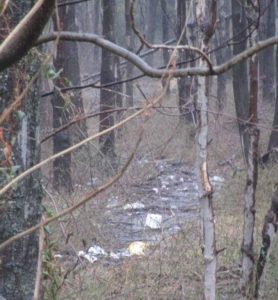
Garbage floating in a Monroe, Middlesex County, drainage ditch
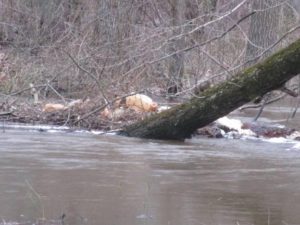
Garbage caught on a tree snag
in Manalapan Brook, Monroe, Middlesex County
NON-POINT SOURCE POLLUTION: During and after the week’s rains, the flow of non-point source pollution was obvious in our waterways. The cost-free way of dealing with it is, do not litter and do not leave stuff out in the yard, then it will not float into waterways.
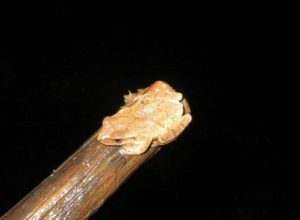
A spring peeper treefrog, found in the Manalapan Brook floodplain
FROGS: I walked into the swamp hardwood forest of the Manalapan Brook floodplain between Helmetta and Jamesburg early in the week. The sleigh bells-like sound of spring peeper treefrogs, “Pseudacris crucifer crucifer,” was obvious. I also heard monkey chattering-like sound of wood frogs, “Rana sylvatica.”
RASPBERRIES: I planted five bare-root Burpee seed company Caroline raspberry plants.
GARDEN ZONES: Depending on the source, the area is Garden Zone 6 (cooler) to Garden Zone 7 (warmer). That means our last frost generally is April 15 to 30; Our first frost is generally Oct. 11 to 20. Beyond that, I am playing it safe and sticking with Zone 6 for my Helmetta area, Middlesex County, home, although the area becoming a solid Zone 7 because of global warming is likely just around the corner.
OUTDOOR PLANTING FOR SUMMER VEGETABLES AND FRUITS: My rule of thumb is May 20 if it is a warm to normal and, if it is cooler, wait to June 1.
PREPARING PLANTS INDOOR: This year, though, I am trying something new, sowing plants indoors before the outside plant dates. So, I am experimenting with Kaleidoscope Blend Organic and Touchon carrots, Iceberg A lettuce, and Sugar Snap peas, all Burpee, which I began sowing about March 5. I added Rutgers tomatoes about March 25. I plan on sowing more tomatoes – Brandywine Red and Red Cherry, both Lake Valley brand – indoors in the next day or so.
HUMMINGBIRDS: Get the hummingbird feeders up by about April 15 to attract the early “scout” birds and they hopefully will lead later-arriving hummingbirds to the feeders.
NIGHT SKY: http://www.skyandtelescope.com/observing/sky-at-a-glance/this-weeks-sky-at-a-glance-march-31-april-8/.
SUNRISE/SUNSET: Approximate times are April 2, Sunday, 6:40 and 7:23 Eastern Daylight Time; April 3, Monday, 6:38 and 7:25; April 4, Tuesday, 6:36 and 7:26; April 5, Wednesday, 6:35 and 7:27; April 6, Thursday, 6:33 and 7:28[ April 7, Friday, 6:31 and 7:29; an April 8, Saturday, 6:30 and 7:30.
WEATHER: Local weather forecasts are available at http://www.weather.gov/phi/.

Carnegie Lake near the Kingston dam
on the boundary of Mercer, Middlesex, and Somerset counties
Joe Sapia, 60-years-old, grew up and lives in the Pine Barrens around Helmetta, where his family has resided for more than 100 years. He can be reached at Snufftin@aol.com or at P.O. Box 275, Helmetta, 08828.
At our May 15 meeting we will welcome Raritan Scholar interns, Rutgers Environmental Stewards, and LRWP volunteers to highlight their work on a diverse set of projects including a virtual tour of the Lower Raritan Watershed, a Story Map of Highland Park’s Mill Brook, NASA’s Soil Moisture Active Passive program in the Lower Raritan Watershed, and more.
The meeting will be held from 10-noon in the Middlesex County Planning Offices at 75 Bayard Street, New Brunswick, NJ – 5th floor mid-size conference room.
Parking is validated for those parking on floors 5 and higher in the RWJ Wellness Parking Deck located at 95 Paterson Street, New Brunswick, NJ 08901. Be sure to bring your ticket to the meeting for validation.
For more information contact Heather: hfenyk AT lowerraritanwatershed DOT org
Our April 17 meeting will focus on stormwater management, and will include a discussion of regional approaches to stormwater management.
The agenda will include an overview of federal expectations with respect to MS4 requirements, with Matt Klewin (NJDEP) presenting on “Update on Changes in the New MS4 Revision”. Manville Borough Administrator Andrea Bierwirth will speak about challenges to meeting MS4 requirements in the upper portion of the watershed.
The meeting will be held from 10-noon in the Middlesex County Planning Offices at 75 Bayard Street, New Brunswick, NJ – 5th floor mid-size conference room.
Parking is validated for those parking on floors 5 and higher in the RWJ Wellness Parking Deck located at 95 Paterson Street, New Brunswick, NJ 08901. Be sure to bring your ticket to the meeting for validation.
For more information contact Heather: hfenyk AT lowerraritanwatershed DOT org
Article by LRWP Board President Heather Fenyk
Wikipedia tells us that civic science or citizen science (CS; also known as crowd science, crowd-sourced science, volunteer monitoring or networked science) is “scientific research conducted, in whole or in part, by amateur (or nonprofessional) scientists. Citizen science is sometimes described as public participation in scientific research, participatory monitoring and participatory action research.”
The LRWP employs civic science to better understand the health of our watershed. Our volunteers engage in activities like water quality monitoring, soil sampling, pollinator counts and mapping of invasive and threatened/endangered species. The data our volunteers generate is a key input to our analyses and restoration prioritization.
While the LRWP’s mission centers on protecting, preserving and restoring habitat and biodiversity within our Lower Raritan Watershed, our civic science approach to data gathering speaks to another core purpose: by training community volunteers to monitor and report on the health of the environment we work to ensure that science, community engagement and environmental stewardship become a permanent part of the culture and identity of the Lower Raritan Watershed.
Want to learn more about citizen/civic science? Not only how it is used to characterize the health of our watersheds, track climate change and map oil spills, but also how it can improve emergency responses, help us understand how diseases spread, and keep our drinking water clean? Check out the new PBS mini-series sponsored by The Crowd and The Cloud. For a month of Thursdays this April, PBS will host a 4-part television series exploring citizen science, crowdsourcing, and mobile technology. Below we summarize the episodes in the series:
Even Big Data Starts Small
The crowd, using mobile tech, and the cloud contribute to science that saves lives. In this episode, you’ll hear stories of everyday people contributing data used for emergency management, researching Alzheimers, mapping oils spills, and more.
World Broadcast: April 6th at 9pm EST
(replayed at 9pm PST)
Citizens + Scientists
Citizen scientists track air pollution in Wyoming, test for lead in Philadelphia’s drinking water, fish for data in coldwater trout streams and report environmental crimes in China, using the “Black & Smelly Rivers” app. Hear all these stories and more in Episode 2.
World Broadcast: April 13th at 9pm EST
(replayed at 9pm PST)
Viral vs Virus
Real-time data helps track environmental triggers for asthma sufferers and citizens confront air pollution and rising asthma rates by collecting real time data. In this episode, explore how maps and apps can combat globalized disease from asthma to Zika.
World Broadcast: April 20th at 9pm EST
(replayed at 9pm PST)
Citizens4Earth
This episode explores a Year in the Life of Citizen Science. Counting birds with an app, surfers collecting ocean data while they ride the waves, volunteers surveying horseshoe crabs on the Delaware Bay, and butterflies wintering over in California.
World Broadcast: April 27th at 9pm EST
(replayed at 9pm PST)
Article and photo by Joe Mish
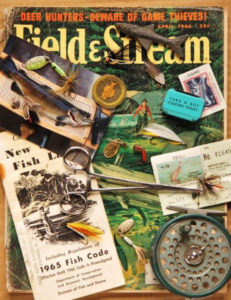
Field and Stream dreams come true on the South Branch of the Raritan. Opening day of the NJ trout season stirs memories as strong as a lifetime of Christmas morning and birthday surprises.
Right along with the anticipation of presents on Christmas morning, April and the opening day of fishing season both involved a dedicated countdown. For a month, each passing day was marked with a big X on the complimentary Esso service station calendar. It was understood, there would be no sleep on the eve of this once a year event.
Times have changed but tradition still lingers as many NJ anglers prepare for the opening of trout season in early April. One of the best places to live out a fishing fantasy is in Branchburg. As the name implies the township is bound for the most part by the North and South branches of the Raritan River, both heavily stocked with trout by the NJ Division of Fish and Wildlife.
Of course trout are not the only game in town. As the river flows from the mountains to the sea, fish can swim upstream as well as down. What that means is tiger muskies and hybrid bass can find their way downstream from Spruce Run as well as stripped bass, hickory and American shad can migrate upstream from the Atlantic Ocean. The state had been using an underwater camera to monitor quantity and species of fish in the area around the confluence of the Raritan and Millstone rivers, species you wouldn’t believe were observed. It was reported in a news article several years ago that trophy brown trout, walleyes, muskies, stripped bass, shad and several forage species were recorded. The beauty of fishing a river is you never know what you might catch.
While trout get the most press, the lower river is primarily a seasonal trout fishery with most angler activity occurring around opening day and subsequent stockings. It is considered to be ‘put and take’ fishing. There are holdover trout but you have to search for them. It is reported trout will travel distances to find suitable habitat with the water temperature being a prime factor. Each species has a preference for a specific temperature range so be sure to carry a thermometer if you want to become serious about your fishing.
The South Branch is also chock full of smallmouth bass which are a year around fish. Fish in the twenty-two inch range have been reported. Smallmouths in the twelve to fifteen inch range have a tendency to tailwalk on the surface of the water while their big brothers often stay deep and pull hard. My favorite lure for these ‘bronzebacks’ is a Panther Martin spinner with a small curly tailed grub on an ultralight fishing rod. Always have a hemostat or thumb forceps handy to remove the hook from any fish you wish to release.
Fishing methods and equipment span the spectrum of human imagination and most are effective on any given day. Expensive Orvis fly rods to lawn chairs and igloo coolers, garden worms to woolly buggers to Mepps spinners all take their share of fish. Fishing allows for as much science, superstition or tradition you might want to use in your piscatorial pursuits. There are even solunar tables which scientifically predict the best days to fish, however, everyone knows the best day to fish is whenever you get the chance.
So if your bumper sticker proclaims, “the worst day of fishing is better than the best day at work”, you already have your gear in ship shape condition and have started your countdown to the April 8th NJ trout season opener for 2017.
Author Joe Mish has been running wild in New Jersey since childhood when he found ways to escape his mother’s watchful eyes. He continues to trek the swamps, rivers and thickets seeking to share, with the residents and visitors, all of the state’s natural beauty hidden within full view. To read more of his writing and view more of his gorgeous photographs visit Winter Bear Rising, his wordpress blog. Joe’s series “Nature on the Raritan, Hidden in Plain View” runs monthly as part of the LRWP “Voices of the Watershed” series. Writing and photos used with permission from the author.
Article and photos by Joseph Sapia
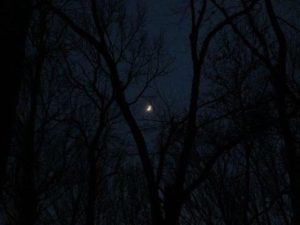
Above the Manalapan Brook floodplain, a crescent moon waxed toward December’s Full Long Nights Moon

Christmastime in Fair Haven, Monmouth County
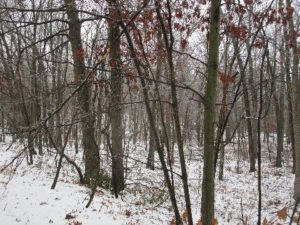
Snowfall of 1-1/2 inches December 17 in the Jamesburg Park Conservation Area, Middlesex County
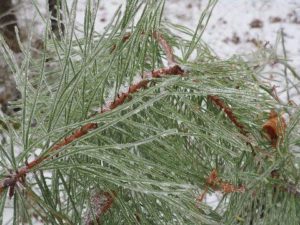
Ice builds up on the needles of a pitch pine, Pinus rigida, the common tree of the New Jersey Pine Barrens. Here, in the Jamesburg Park Conservation Area in the Pine Barrens around Helmetta.
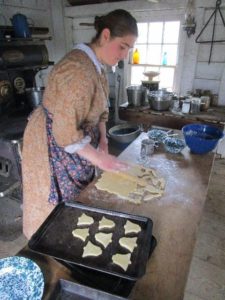
Christmastime at historic Longstreet Farm, the Monmouth County Park System’s living history farm, replicating the late 1800s in Holmdel. Here, baking cookies the old-fashioned way.
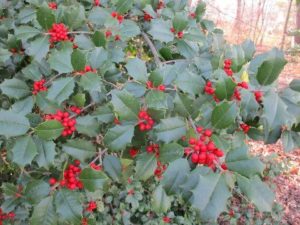
Holly in my neigbhorhood in Monroe, Middlesex County.
Joe Sapia, 60-years-old, grew up and lives in the Pine Barrens around Helmetta, where his family has resided for more than 100 years. He can be reached at Snufftin@aol.com or at P.O. Box 275, Helmetta, 08828.
Article and photos by Joseph Sapia

Shekiro’s Pond in Helmetta
Joey Slezak grew up in South Jersey, but he has multi-generational roots in the Pine Barrens around Helmetta and has lived in his parental grandparents’s former house in Helmetta while studying at Rutgers University in New Brunswick. In his own right, Joey is a meteorology student at Rutgers, an outdoorsman, and, importantly to me in the outdoors, my go-to science guy.
I was looking forward to walking afield with him – perhaps not on as cold a day as February 18, 2015. Minus 1 degree at dawn and 9 degrees when I left my house about two hours later. But between our schedules, we had to take advantage of this opportunity, cold or not. Plus, we are woodsmen from Helmetta of tough local Polish stock. So, we plunged into the approximately 15 degrees when we finally started walking before 10 a.m.
A woodpecker hammered away. A few inches of snow covered the ground – on the surface, it was fluffy — and clung to trees.
“You could see the snow fall from the trees, these little flakes go by,” said Joey, 22-years-old at the time and working on his bachelor’s degree in meteorology.
On this day, we would spend much time in wetlands, including an Atlantic white cedar swamp being threatened by invasive phragmites.
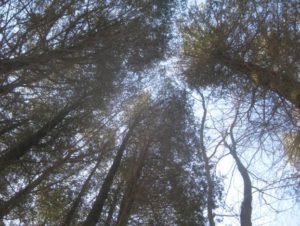
Looking skyward from the Atlantic white cedar swamp
“This is probably as secluded as you could be in these woods,” I said.
It was very quiet, until a jet airplane flew by.
“The final approach to Newark Airport comes over us,” Joey said.
Despite the cold, I was surprisingly warm.
“Once you heat up your clothes, there’s no wind to dissipate it,” Joey said. “(And) you’re dressed for it.”
I was dressed in long underwear, bottoms and tops; covered with a sweater and windbreaker jacket, all made of materials to wick sweat.
Joey pointed out hoar frost, a crystallized coating of frost. With the hoar frost, Mother Nature worked her art on any icy surface of water and on blades of vegetation.

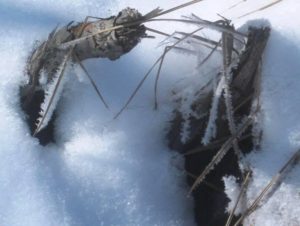
Mother Nature’s artwork: hoar frost.
Here and there, we were in danger of breaking through the swamp ice. I went up to my shins at one point, up to my thigh at another. Joey noted how he could smell the swamp when I broke through.
As we walked, we noticed evidence of the day’s low humidity – in the clarity and blueness of the sky.
“Not a cloud in the sky (hardly), a bluebird day,” said Joey, who, now in 2017, is working on his master’s degree in atmospheric science.
As we walked a sand road, we noticed fallen trees, lying northeast to southwest.
“That’s probably coastal,” Joey said, meaning a storm out of the east, rather than in the normal flow of wind from the west.
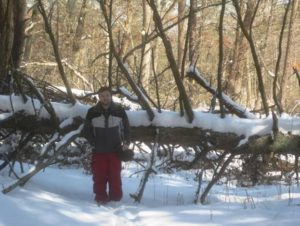
Joey Slezak at a treefall.
Perhaps the highlight of the day was hearing the call – a running-a-finger-along-the-teeth-of-a-comb sound — of a New Jersey chorus frog. This frog is an early caller, breeding as early as February, according to New Jersey Division of Fish and Wildlife literature.
“That sun’s getting warm,” Joey said.
By the time we ended the walk at lunchtime, the temperature was about 30.
“I had a lot of work to do, a lot of stress,” Joey said. “It felt pretty good to get out there.”
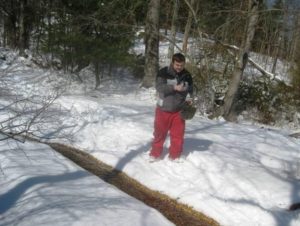
Joey Slezak at a small stream
Joe Sapia, 60-years-old, grew up and lives in the Pine Barrens around Helmetta, where his family has resided for more than 100 years. He can be reached at Snufftin@aol.com or at P.O. Box 275, Helmetta, 08828.
Article and photo by Joe Mish
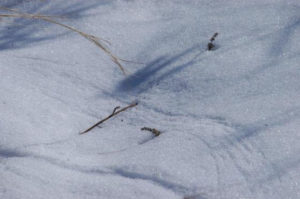
The hand of the wind uses the delicate grass to etch its thoughts in the snow. Nature’s secrets are whispered among the wooded hills and fields for all who pause to ‘listen’.
March is the month when winter puts its house in order to depart our latitude on its tour of the earth.
Remnants of left over winter wind, swept from dark, frozen nooks and crannies, are set free to blow themselves out in the twenty days leading to the arrival of spring.
The force of the wind breathes life into tree canopies and grasses as they dance and sway to the tune of the invisible but palpable energy. There is joy expressed when those, planted in place, unable to change location, experience rhythmic movement in perfect time.
A linear mass of silver maple trees, along the river’s edge, branches tipped with red velvet buds, sway in unison, as they execute a perfect ‘wave’, encouraged on by a burst of wind which leads the cheer.
Consider that the trees and tall meadow grass have evolved to take advantage of the wind. Dispersion of seed that still cling to stems and pods are sent aloft on a later flight to give the best chance for germination than seeds dispersed months earlier.
Trees benefit from the March wind as broken, insect infested branches are excised in a manner to suggest surgical intervention to remove a cancerous limb. The wind effectively prunes tree branches to allow sunlight to penetrate the canopy and promote new leaf growth; each leaf a new solar factory to boost the tree’s nutrient supply.
The wind has a wide range of expression that arises from deep internal turmoil. Perhaps the wind offended the gods in a prideful manner that justified eternal punishment. The gods therefore made the wind invisible to all the senses except for touch, and then only when the wind moves.
The wind constantly struggles with this blow to its vanity and does its best to make its presence known by channeling other elements.
Think about the wind and the scale of expression from hurricanes and tornadoes to a gentle whisper, where the wind uses a dried stem of grass or tree branch to etch its thoughts in the snow or the side of a wood building.
A spring breeze, carrying the scent of lavender blossoms, adds another dimension to the wind’s ‘visibility’ as the wind assumes the identity of the aroma. This is an expanded statement of expression; a loophole to get around the punishment imposed by the gods. This pleases the wind.
As the wind struggles to regain its physical identity and frustration builds, snow and ice are incorporated to flesh out the wind and give it a visible form.
Sometimes the desire to be seen is so fierce, the wind driven snow and ice makes the sense of sight useless, adding to the wind’s frustration, causing it to howl louder and blow harder.
The blustery wind, complement of March’s winter legacy, eventually subsides to become the gentle breeze of spring. The edge of winter passes and tempers the winds attitude to more gentle expressions of mood.
Author Joe Mish has been running wild in New Jersey since childhood when he found ways to escape his mother’s watchful eyes. He continues to trek the swamps, rivers and thickets seeking to share, with the residents and visitors, all of the state’s natural beauty hidden within full view. To read more of his writing and view more of his gorgeous photographs visit Winter Bear Rising, his wordpress blog. Joe’s series “Nature on the Raritan, Hidden in Plain View” runs monthly as part of the LRWP “Voices of the Watershed” series. Writing and photos used with permission from the author.
Article and photos by Joe Mish

A juvenile myrtle warbler searches the ice shrouded shoreline of the South Branch in late February
February is midwinter’s better half, given it is two days shorter than any other month and two days closer to spring, a virtual, ‘get out of winter free, card’. The significance of those two missing days provides a powerful psychological boost to soothe winter doldrums and seasonal affective disorder accumulating since December.
Although spring is the ‘finish line’ for surviving winter, the early days of spring are often indistinguishable from winter weather. This demonstrates that our characterization of the seasons is based more on legend than reality, especially when a lingering winter feels like an eternity.
Moving from impressionable feelings and missing days to more tangible evidence, February provides many visual clues that spring is around the corner. Its 28 days are a prelude or appetizer, stirring the emotions, building anticipation for the main event, the first day of spring.
To see visual clues we need light and light is what February delivers. In 28 short days we gain about an hour of day length, most evident to causal observers by noting the later time of sunset.
The increasing day length triggers a response in people and animals as we see the start of bird migration, courtship, flowers and tree buds.
Bird migration is one of the most colorful visual cues that winter has run its course. The milder the winter the earlier migration begins. Migration may be local, as with bluebirds or two thousand of miles away for many of the colorful warblers.
Late February usually marks the very beginnings of small bird migration north. Our rivers, streams coastlines and even interstate roadways provide linear pathways for migrating birds. The most colorful and plentiful are the myriad of warbler varieties. It is not unusual to see a bright flash of color darting along the riverside in late February despite shoreline ice and cold weather. A band of north bound travelers may find temporary shelter during a cold spell on south facing hillsides or in brush along steep river banks, protected from the wind and saturated with full sun.
Hawks are usually seen now in pairs as they bond prior to nesting. The owls hooting on cold winter nights and local bald eagles may well be incubating eggs.
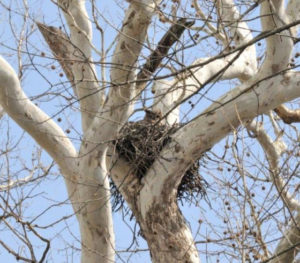
Great horned owl nesting in am old red tailed hawk nest
Muskrat, mink and fox are out and about in a courting mood. This is the time to scan fields for red fox roaming the countryside looking for mates. Love is definitely in the air.
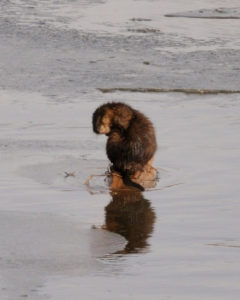
Muskrats are more often seen during their late winter early/ spring courting season
Male white-tailed deer have dropped their antlers and females are heavy with fawns as day length triggers hormonal changes to alter behavior and ensure best chances for winter survival. Now is a good time to walk the fields and woodlots to look for dropped antlers.
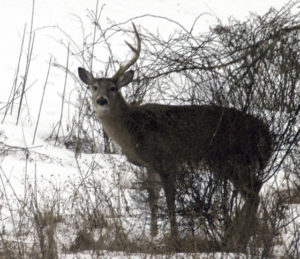
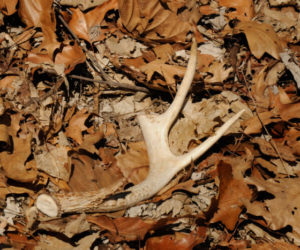
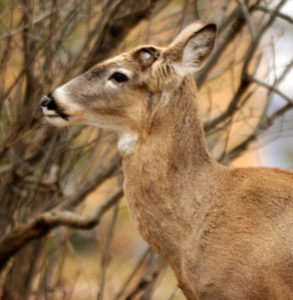
A buck has dropped one antler, the other will soon drop perhaps when it jumps a fence. A dropped antler charcterized by an irregular base. Antler buds after the antlers drop. Within a couple of months, the antlers will begin to sprout from these buds surrounded by viable tissue with a velvety appearance that readily bleeds if injured.

The first and most consistent sign of spring for me is the blooming of snowdrops, en masse on a hillside, near where I usually launch my canoe on the South Branch. As cold as it might be, the sight of those tiny white flowers gives me inspiration, fires my energy and issues a solemn promise of the return of spring.
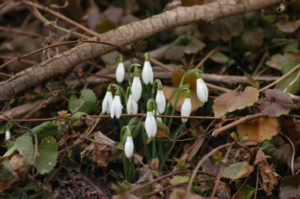
A patch of snow drops blooming midwinter heralds the return of spring
By February, the deep red leaf buds, on the trees that line the river, stand out against brown and gray interlaced branches. When viewed at a distance, the contrasting colors are enhanced as they take on a solid appearance as if created by long horizontal brush strokes in a painting.
A full moon will occur on February 11th to light up the night, as a compliment to the lengthening daylight, to make February a well lit marquee announcing next month’s arrival of spring.
Author Joe Mish has been running wild in New Jersey since childhood when he found ways to escape his mother’s watchful eyes. He continues to trek the swamps, rivers and thickets seeking to share, with the residents and visitors, all of the state’s natural beauty hidden within full view. To read more of his writing and view more of his gorgeous photographs visit Winter Bear Rising, his wordpress blog. Joe’s series “Nature on the Raritan, Hidden in Plain View” runs monthly as part of the LRWP “Voices of the Watershed” series. Writing and photos used with permission from the author.
Photos and Article by Joseph Sapia
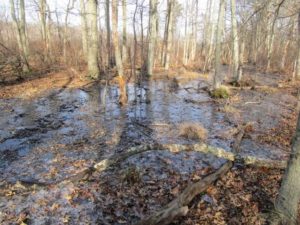
A pond at Szeliga’s Orchard
On this near-to-Christmas day, I was without my Jeep, which was in the shop for most of the day for routine, but time-consuming, maintenance. Without a vehicle, I was living life by foot – walking a mile or so to lunch at the old general store in Helmetta and picking up my mail from my third-generation Post Office box next-door. The walk was to be pragramtic, rather than playful, although I chose a route skirting the woods, instead of walking the Main Road directly from my neighborhood.
After 60 years of living and about 40 years as a journalist, I should know, Be ready for what is out there, unexpected or not. As a woodsman here in the Pine Barrens around Helmetta since old enough, I should know, A walk is not simply a walk.
So, I was glad I put my camera in my pocket.
Before I even left the neighborhood, I came upon a cluster of holly, thick with leaves and holding many berries. A Christmas treat – and my first photographs.
After about three blocks, I went afield, getting on the Pipeline, then onto the freight railroad tracks. Almost immediately on the tracks, I saw a dead mouse lying on a tie between the rails . A victim of a hawk or fox or some other cause of death? I do not know, but another photograph.
As I walked the tracks north, toward Helmetta, I noticed two species of pine: pitch, with its long, swirled needles in clusters of three, along with Virginia, with short, swirling needles in clusters of two. Their green contrasted nicely against the clear, blue sky.
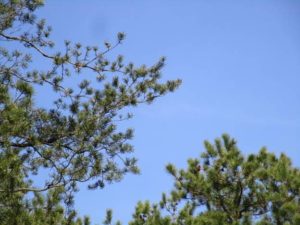
Virginia pine to the left, pitch pine to the right
After crossing Saw Mill Brook, I noticed a third pine in the old Szeliga’s Orchard: white, with supple needles in clusters of five. The species being easy to remember with its five needles, or W-H-I-T-E. It is not a native, here. This was probably an escape from nearby houses.
In the old orchard, I saw ground pine, or Lycopodium. Also, there was a nice little pond – I knew of the swamp, here, but did not remember this much ponding. And there was a fallen tree trunk, pecked by a woodpecker or woodpeckers.
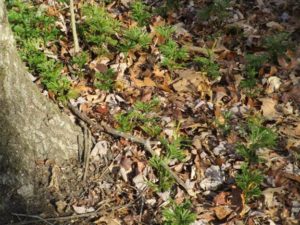
Ground pine at Szeliga’s Orchard
I got to the former worker homes of the George W. Helme Snuff Mill — which ceased production in 1993 and, this year, opened as apartments — and cut through the alley dividing them. After a visit to the Post Office and lunch at the store, I walked to Helmetta Pond.
There, I found a thin layer of ice along the shore – the temperature was now in the low 40s, but overnight it had got down to about 30. Canada geese sat in the pond on its other side by the woods. There, it was a mix of pines on the high ground, swamp hardwoods and Atlantic white cedar in the wetlands – and, it seemed, more and more invasive Phragmites reed grass.
On the way back, I took photos of ice in a ditch and Shekiro’s Pond, which had a cluster of punks, or cat-tails, dying off in the cold weather. Shekiro’s was fending off Phragmites nicely, unlike the Pond to the north and Cranberry Bog to the south.
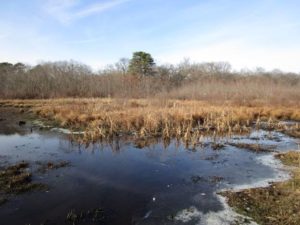
Shekiro’s Pond
At the Bog, I spooked a great blue heron, which took off slowly in flight. But not slowly enough for me to get a photograph. I did stop nearby, though, to shoot a stand of birch on the old Shekiro homestead.
On my way home, I was treated to a ConRail locomotive pulling two hopper cars toward Jamesburg. I snapped photos of the train, glad I had the camera with me over these few hours.
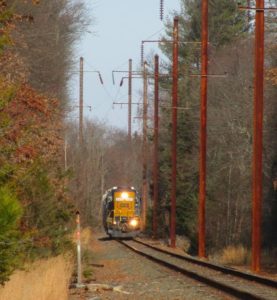
A ConRail train in Helmetta, heading toward Jamesburg
Joe Sapia, 60-years-old, grew up and lives in the Pine Barrens around Helmetta, where his family has resided for more than 100 years. He can be reached at Snufftin@aol.com or at P.O. Box 275, Helmetta, 08828.
Copyright 2016 by Joseph Sapia































